When the Leaf Falls
By John Palka — Posted December 2, 2017
The early days of autumn have a special quality to them. They are often both sunny and crisp. You can feel that the summer is coming to a close and life on Earth is entering a new phase. The leaves on the trees are starting to change color. And if you pay close attention, you can see them flutter down from the branches and start to accumulate on the ground below, as we saw in the previous post.
One day in September I was doing just that. The sun was out. The air was still. Most of the leaves on the alder trees all around me were still green, but some had turned partly or completely yellow. And every so often I would catch sight of a single leaf tumbling through the air and landing softly on the ground or on the grass, keeping company with its fellows that had fallen earlier.
How did this happen? There was hardly a breeze, so the occasional falling leaves were not being dislodged by force. And not every yellow leaf in the canopy had fallen. All of a tree’s brightly colored leaves do not fall right away, else how would we ever be treated to those flaming autumnal forests of the Midwest and Northeast? Why, in short, were some leaves falling as if the trees had gently let them go, while most still clung to their parent branches? Was it happenstance, or did the trees regulate the fate of their leaves? Let’s look more closely.
LETTING GO AT THE ABSCISSION ZONE
When leaves drop, their stems (petioles) separate from the branch to which they had been attached at specialized abscission zones. An abscission zone is formed of some half-dozen layers of cells whose walls, at the right time of year, become thinner and thinner until they ultimately separate from each other and/or rupture altogether. Once this happens, all that holds the petiole to the branch is the cells of the vascular bundles, the slender assemblies of elongated cells that carry water, nutrients, sugars, and hormones to and from the leaves where they branch out as the conspicuous veins. Soon this not enough and that particular leaf falls under its own weight or in the blowing breeze even if that breeze is very gentle.
Below is anatomical evidence of this process. In the first photograph (included also in the previous post) we see the base of a leaf of a red alder (Alnus rubra) with its venation showing, and the petiole by which the leaf is attached to its branch. In the angle formed by the petiole and the branch, called the axil, is a bud from which a fresh leaf will emerge next spring. We paid special attention to axillary buds in the previous post. Today we will focus on the leaf and its petiole.
In the next photograph we see what remains on the branch when such a leaf falls. It is a neatly formed scar, smooth and continuous. This scar is formed by the stem-side remnants of the abscission zone. The interrupted vascular bundles are clearly visible.
I took this picture just moments after a gentle brush of my hand dislodged the leaf from the stem. I caught the leaf, so I was able to photograph the leaf side of the same abscission zone. You see this in the photograph below. As on the branch, the separation surface is smooth and continuous and the vascular bundles are clearly defined. Because I took these photographs within a minute of the leaf’s separation from the branch, what you are seeing is the tissue as it was at the time of separation, with no significant drying or other modification.
THE MECHANISM OF ABSCISSION
We have seen thus far that leaves do not fall willy-nilly. Rather, they are designed to fall when the right time comes. Direct observation teaches us that leaves fall primarily in the autumn, and that by the time they fall they have lost the capacity to photosynthesize. Thus, there is coordination between the season, the ability of a leaf to photosynthesize, the separation of the abscission zone, and the ultimate death of the leaf.
How does the abscission zone form? Each leaf of a deciduous tree is predestined to fall. The abscission zone forms early in the development of the leaf. Indeed, in many species the cells of the future abscission zone are recognizable in the leaf bud long before it opens, and thus they are present throughout the lifetime of the leaf. Until the time for release approaches, however, the cells of which the abscission zone is composed hold the leaf firmly attached to the stem, resisting even powerful winds.
By what mechanism are the cells of the abscission zone weakened at the appropriate time? The cells of the abscission zone act like ordinary plant cells for months, with rigid cell walls firmly attached to one another. During abscission these walls become fragile and prone to separation from each other. This change is generated by enzymes—especially pectinases—which actually digest the molecules that hold the walls of adjacent cells to each other.
What happens after abscission? The release of the leaf is not the end of the story. Each leaf scar constitutes a fairly sizeable region in which the interior of the branch is exposed to the external environment and thus is susceptible to the loss of water by evaporation as well as to invasion by pathogens. This situation does not last long. Very quickly, and in some cases even before the leaf actually falls, the cells on the stem side of the abscission zone start to synthesize and deposit in their cell walls molecules that allow these cells to form a protective layer, this function replacing the earlier one of forming a separation layer. The principal molecules are lignin and suberin. Neither is limited to the abscission zone. Lignin is distributed throughout woody tissue and contributes to its toughness. Suberin is often associated with corky bark and the external layers of roots where it forms a water-impermeable layer.
You can recognize the process of suberization by the color that the leaf scar develops. The picture below was taken just six hours after abscission, and already you can see an orange-brown coloration developing.
And here is what the leaf scar looks like at four days. The entire surface has been suberized and lignified.
The wound is now thoroughly sealed against water loss and infection and will remain so for the rest of the life of this stem.
WHAT SETS THE PROCESSES OF ABSCISSION IN MOTION?
The immediate cause of the changes that take place in the cells of the abscission zone in the fall is the action of hormones. We have seen previously that hormones influence cellular behavior in plants, just as they do in animals. In particular, we saw that the hormone auxin regulates cell extension and is part of the mechanism that allows a plant to grow straight upward, away from the pull of gravity.
Auxin also plays a role in leaf abscission. This hormone is produced both at the tip of a twig and in the leaves, so that during the summer there is abundant auxin available to the cells of the abscission zone. In the fall, however, many metabolic processes in a leaf begin to change in preparation for its ultimate death, and this includes a decline in the synthesis of auxin. With falling auxin levels, the cells of the abscission zone become more sensitive to a second hormone, ethylene.
Ethylene is actually a gas whose best-known role is in the ripening of fruits. In commercial agriculture fruits are often picked before they are ripe, in part because they are less tender and thus less easily damaged during picking and storage. Their ripening is later promoted by exposure to ethylene. According to current models, ethylene also promotes abscission. The broad hypothesis is that auxin keeps the sensitivity of the cells to ethylene in check. As auxin levels decline, this sensitivity rises. Since ethylene promotes abscission, the process is set in motion.
How does ethylene regulate the synthesis of the enzymes that produce abscission? Ethylene affects the activity of many—hundreds!—of genes in the cells of the abscission zone. Among them are the genes than encode the enzymes that are required for abscission. Thus, ethylene promotes abscission by regulating the expression of genes.
This is one example among many of the idea that genes are not passive entities that reside in the chromosomes and encode gene products according to some predetermined scheme. Rather, they are dynamic entities whose activity is constantly modulated by a range of factors, hormones among them. We have encountered this notion already in our look at the beautiful patterns in butterfly wings.
What signals prompt the decline in auxin synthesis? We humans are good at sensing the end of summer. The days start to get shorter, the color of the light seems to be different than it was in mid-summer and, while the temperatures may vary, the nights are noticeably cooler. It may be hard to pin down all the cues, but overall we are aware of the transition from summer to fall.
Plants are perhaps even more sensitive than we are to the change of seasons because, being immobile and thus not able to escape the changing conditions, they need to adapt to these conditions in place. The mechanisms that allow the lives of plants to be matched so exquisitely to the changing seasons will be the subject of a future post. Stay tuned!
OUR EVER-CHANGING WORLD
The seasons are always changing. Consider keeping a written record of what you see in the woods from time to time and most particularly, perhaps, during the transition seasons of fall and spring. Keeping notes will inspire you to pay closer attention, and paying attention will open both your mind and your heart to the wonderful world of which we are a part.
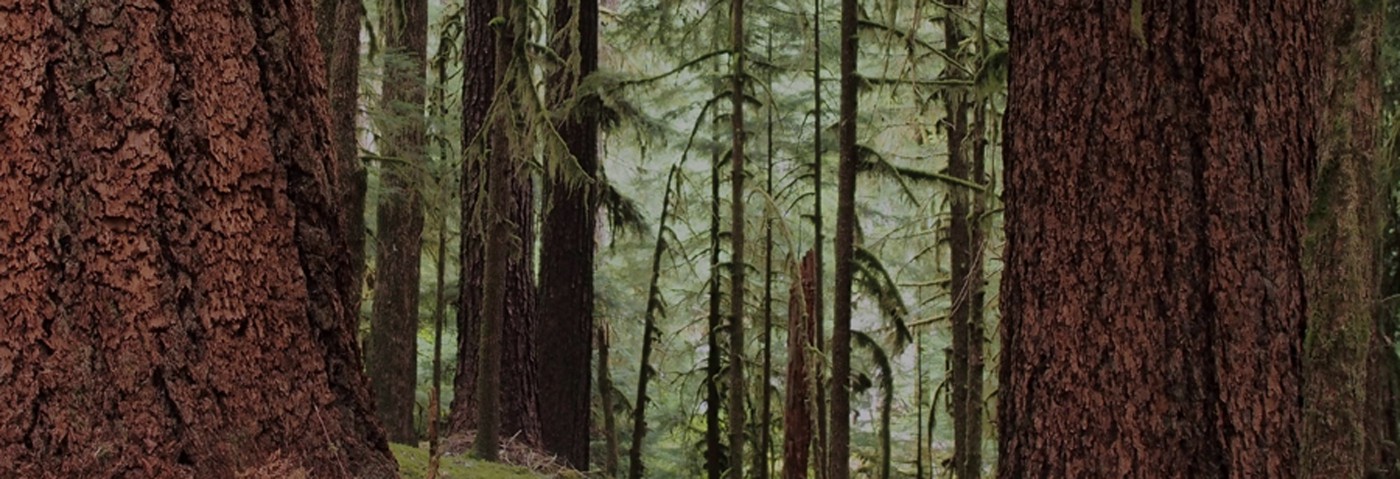
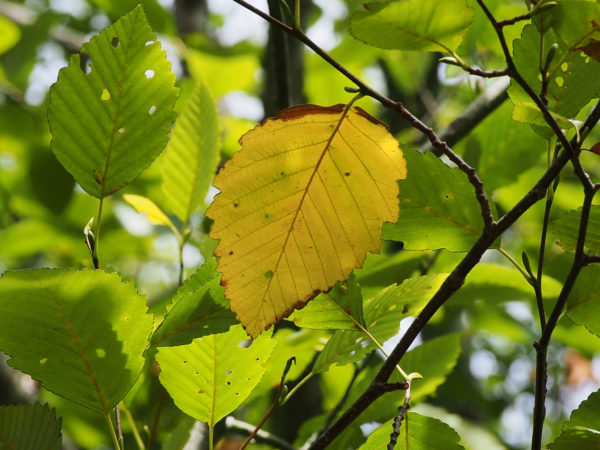
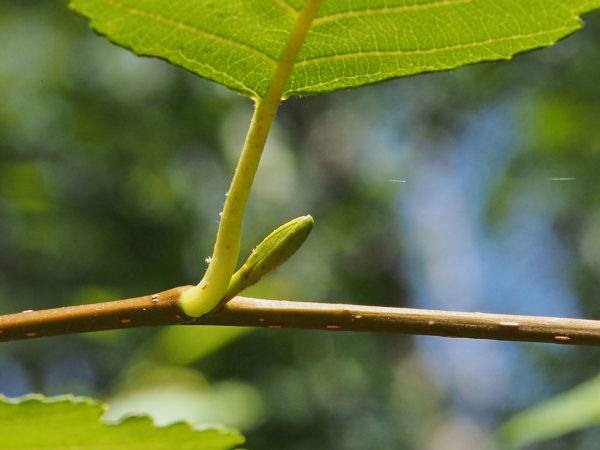
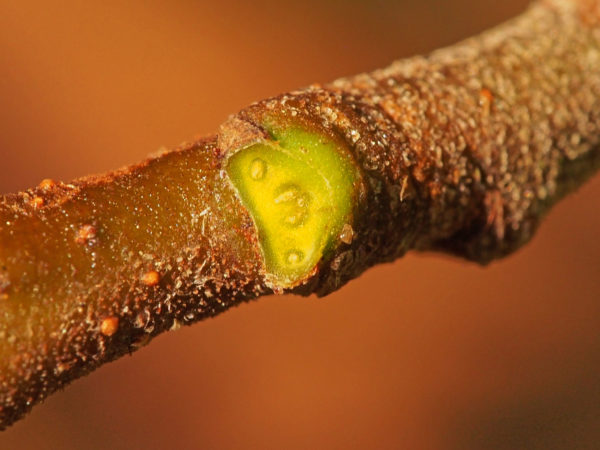
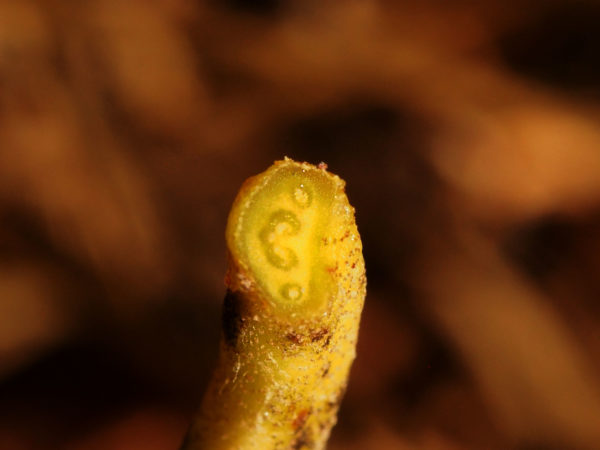
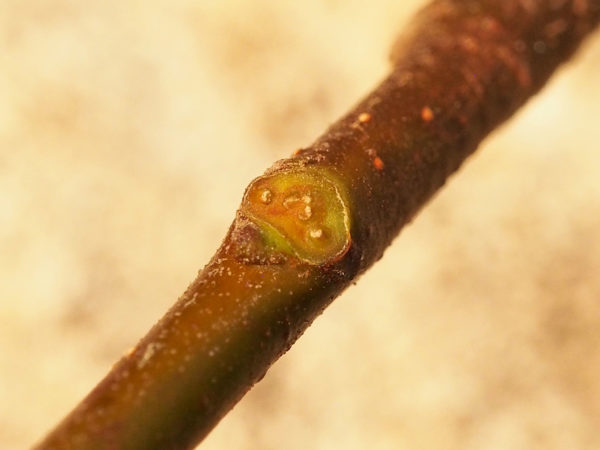
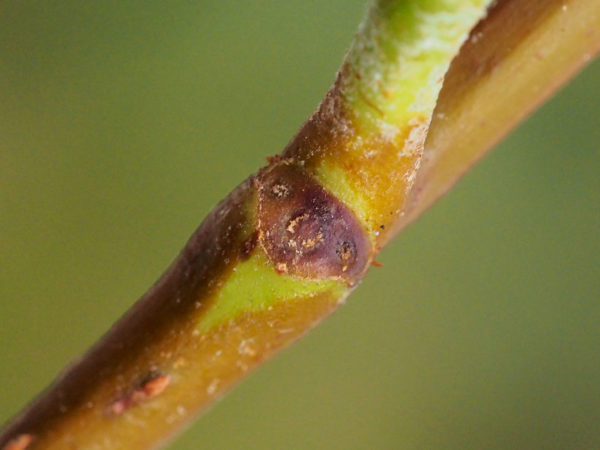
What a fascinating process! Thanks, Johnny!
Nature is amazing, isn’t she?
This is just what I was looking for, having walked home down a path an hour after leaving where, all of a sudden, the oaks and other trees cascaded down their leaves, all at once, like confetti. I wondered about what variables of confluence occurred in that one glorious five minutes where so many fell at once. It was unspeakably gorgeous.
I love the photographic documentation of abscission! Thank you. Your photos enliven the process for us. Oh Madurai… Enjoy!
It was great fun to photograph with such a specific goal. The alders proved to be very agreeable subjects!
You got me… Picked up a freshly fallen leaf here in Madurai… A nice distinct pattern had formed showing the abscission characteristics you described. An older leaf nearby was showing the onset of darkening.
Fun..! Thnx, Marty
You are a true naturalist, Marty!
John, Two questions. Is there a different set of cues (or is it just aging) that let Quercus virginiana (the Live Oak) drop its leaves not in the fall but at other times — people often say here in Louisiana that the new leaves “push off the old leaves,” which I assume to be incorrect.
And second, I’m wondering if there is some chemical gas that would be the opposite of ethylene, which one might bathe a bonsai in (for example) to keep the leaves on a tad longer (for example to keep them on a week longer if a big show is looming). For some unarticulated ethical reason I don’t like the latter idea, but I’m wondering if it would be theoretically possible.
Thanks,
Michael Cavanaugh
A number of oak species keep their leaves through the winter even though those leaves have died. I have to look into the mechanisms that cause them to finally drop these dead leaves as spring is approaching or starting. Homework for me! As for countering the effects of ethylene, I do not have a ready answer for this either. There might be a light regime or something like that to help maintain high auxin levels. This, however, is pure speculation.
I was thinking about the same phenomenon as I read this piece, as it is something I’ve always been curious about. The term for the phenomenon you’re describing is “marcescence.” It is well documented, but not well understood. There are a number of unsatisfying theories about why trees might do this in the ultimate sense (protecting lower twigs from deer browse in winter, mulching the ground in early spring, allowing lower leaves to continue photosynthesis a few weeks longer but then catching them off guard before abscission layer develops, etc.), but I’d love to hear more about proximate theories for why they do this. One observation I have made is that it is usually the leaves on the lower part of the tree that are retained. Does this have to do with where and how hormones are produced and travel within the tree (in which case maybe the leaves _are_ caught before abscission layers develop in the lower leaves? Or maybe oaks don’t form robust abscission layers and the leaves at the bottom of the tree are less vulnerable to the same winter winds that might cause the final separation of the upper leaves?
Loved the photos and learning all about this! A walk in the woods will never be the same for me, knowing so much is going on.
That thought delights my heart!
I’d read the science of this process before but your photos made it come alive for me. Thanks.
I’m glad. Taking them was both a challenge and a delight.
This was a delightful post. giving me more respect for the simple act of a leaf falling being a very, very complex and diverse process. Thank you! I am reminded of the often seemingly chaotic and sometimes with a beautiful swirling or rocking pathway that different leaves take on their path to the ground and wonder at that.
Thanks, Marc. I think this is a great example of seeing a world in a grain of sand – the deeper you peer, the more wonders are revealed and the broader your understanding and appreciation get. I, too, had a reaction of respect, both for the complexity of such a seemingly simple process and for the way it is tuned to the wider world.